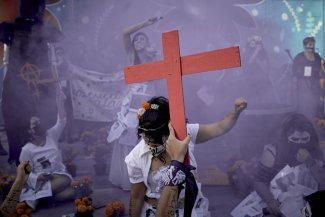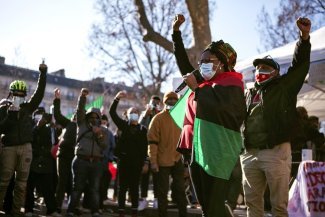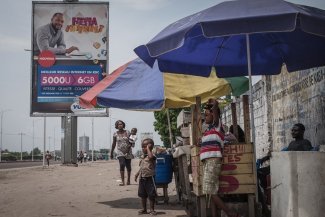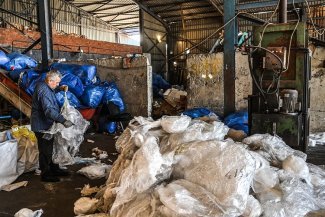In this photo, from December 2016, Rohingyas in a refugee camp in Cox’s Bazar district (Bangladesh) follow the news broadcast on television in silence.
Thengar Char, a 40-square-kilometre island in the Bay of Bengal, does not appear on most maps. It is uninhabited, has no mobile telephone reception and is under water for a large part of the year. The Bangladesh government has, nevertheless, chosen this place as a “temporary measure” to relocate the thousands of Rohingya refugees fleeing from the state of Rakhine (formerly Arakan) in Myanmar (formerly Burma). Dhaka claims that the arrival of migrants from the neighbouring country has led to an increase in crime and the risk of disease, as well as damaging the tourism industry.
Human rights groups are opposing what they consider to be a forced relocation. The plan had already been proposed on previous occasions (the last time in 2015) but was suspended following a wave of criticism from the international community and human rights activists. The Office of the United Nations High Commissioner for Refugees (UNHCR) has, moreover, pointed out that it is a highly “complex and controversial” plan that would have to be carried out with the refugees’ consent.
The Bangladesh authorities nonetheless announced, on 28 February, the launch of a census of Rohingya refugees living in the southeast of the country, indicating that they intend to go ahead with the plan. Completing the census could take at least three months.
For Ashraful Azad, assistant professor at the department of International Relations at the University of Chittagong in Bangladesh and an expert on the Rohingya issue: “The relocation plan is mainly influenced by the motive of stopping local integration of the refugees, which is already underway, through marriage, education and employment.
“It may also serve the purpose of indirectly forcing the refugees to choose to return to Myanmar rather than living in a harsh and remote island.” The border posts of the two countries have seen dozens of Rohingyas returning to Myanmar since the beginning of March, which may be an indication that this indirect approach is, indeed, working.
According to the Bangladesh government’s estimates, around half a million Rohingyas (around 30,000 of whom have official refugee status) are living in the country, including the 73,000 or so who have arrived since the latest outbreak of violence in Myanmar’s Rakhine State, in October, triggered by the attacks on three Burmese border posts, allegedly carried out by a group of Rohingyas.
Rohingya refugees and residents together with human rights organisations have since accused Burmese security forces of summary executions, gang rapes, arbitrary detentions and arson.
Around 1.1 million stateless Rohingya Muslims (an ethnic, linguistic and religious minority) live in apartheid-like conditions in Rakhine State in southwest Myanmar, a Buddhist-majority country. In 1982, the Burmese government passed a law designed almost exclusively to exclude them. The legislation granted citizenship rights to 135 ethnic groups recognised by the government, but did not include the Rohingya.
Burma refers to them as Bengalis, and they are classed as illegal immigrants from the territory that currently corresponds to Bangladesh, which does not recognise this community as its own either. Many Rohingyas live as refugees in Cox’s Bazar, a district bordering Rakhine State and which is also one of the country’s main tourist attractions.
The Rohingyas are considered to be one of the most persecuted minorities in the world.
Bangladesh’s Foreign Minister, AH Mahmood Ali, recently said that the presence of Rohingyas in the district had adverse effects on the overall socio-economic, political, demographic and security situation, due to the rise of illicit drug smuggling and human trafficking rings. He also insisted that the existing accommodation arrangements were already “overstretched” and arranging shelter for the new arrivals has become a “new challenge”.
In its bid to transfer the displaced people to the island, the government called, at the beginning of the year, on the United Nations and other international partners to assist in making the island “habitable” (a project of great magnitude for which no figures have been advanced), and with transporting Rohingya refugees to the new location.
Chris Lewa, director of the Arakan Project – which has been monitoring the Rohingyas’ movements for over a decade – told Equal Times that the “refugees don’t want this”, referring to the abysmal conditions on the island. “They would rather remain nearer the border to be close to their relatives.” Lewa is sceptical that international donors will provide the economic assistance required for the government to implement its plan.
The UNHCR will not be one of the donors, Vivian Tan, spokesperson for the UN refugee agency in Asia, assured Equal Times. The agency is proposing, as an alternative, prioritising the need to “register and document” the Rohingya living in Bangladesh to help humanitarian agencies to “target assistance to those who need it most”.
According to a source familiar with the plight of the Rohingya, and who wishes to remain anonymous given the sensitivity of the issue in Bangladesh: “A portion of the Bangladesh government believes that large-scale works on the island can make it habitable.”
The problem Dhaka is faced with, continues the source, is that “the refugees are not a ‘temporary’ matter, as initially thought”.
In addition, “The Rohingya cannot be forcibly repatriated to Burma and it may be that many decide not to return to the country in the event that Burma approves this option – in the talks being held in this respect between the two countries’ governments.”










